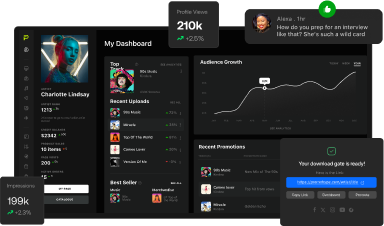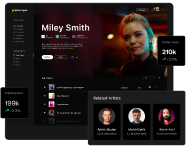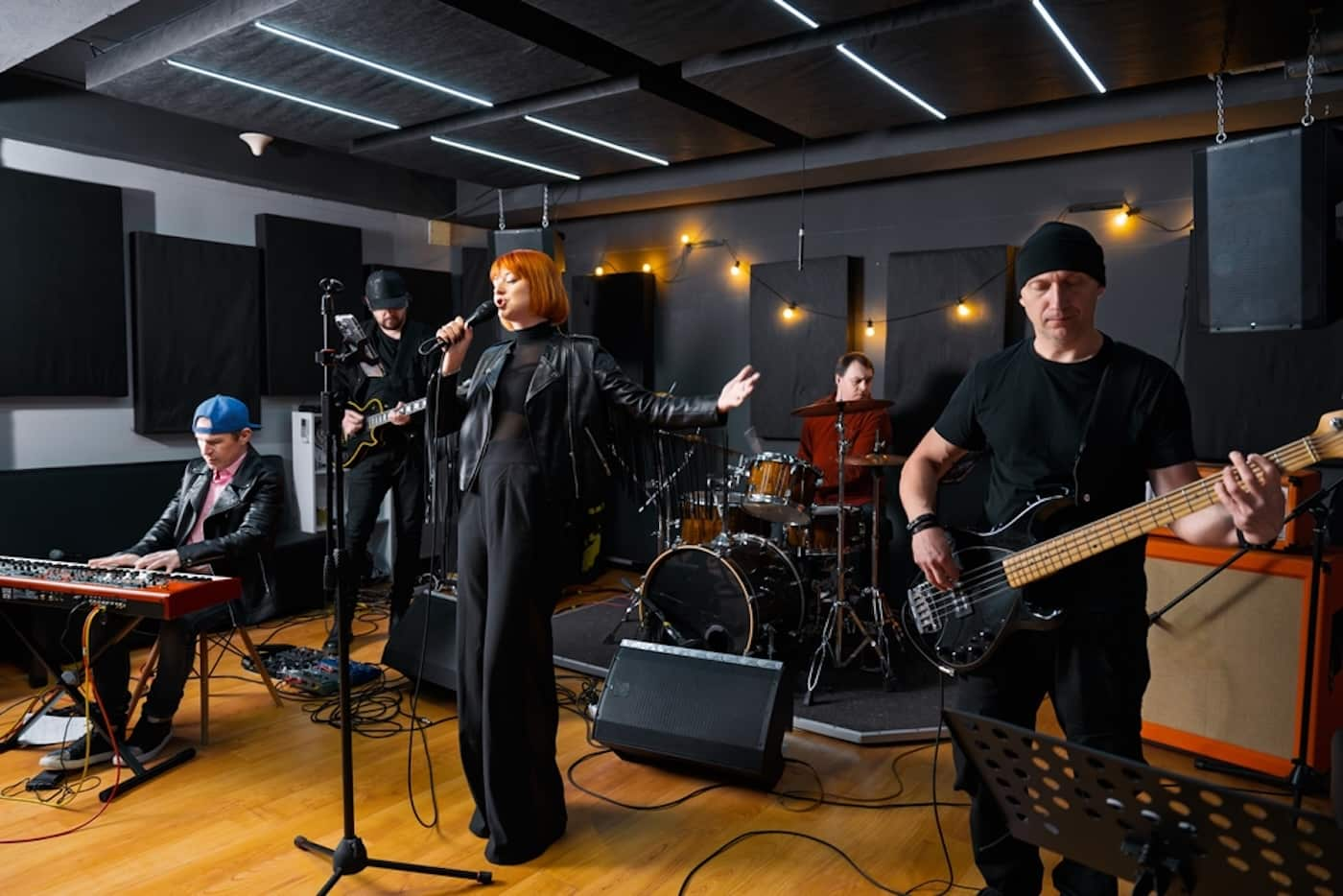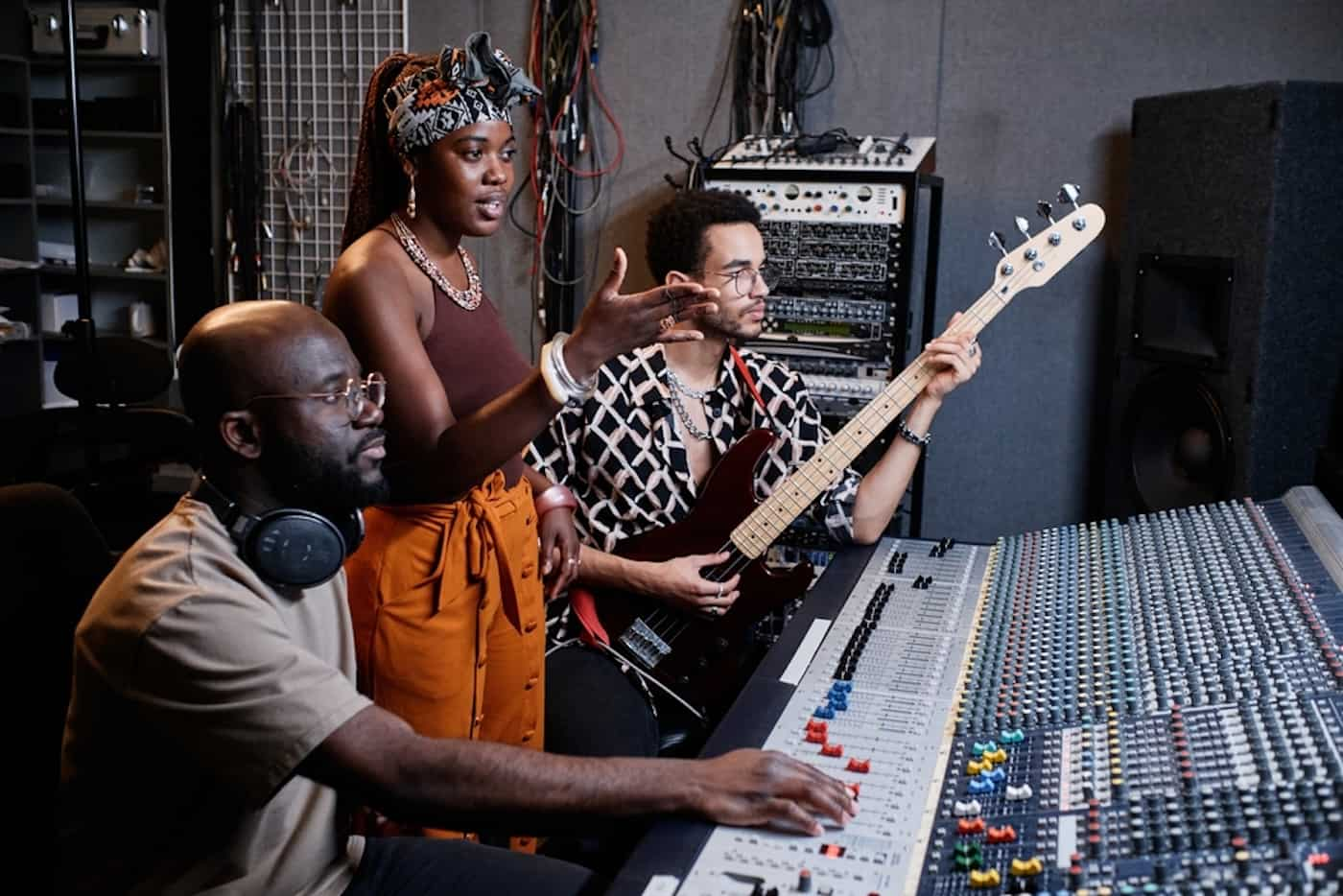
Securing media attention is one of the quickest ways to increase your visibility as an independent artist. That’s why electronic press kits (EPKs) have become a cornerstone of music promotion.
Whether you’re preparing for a new album release or gearing up for a tour, your EPK acts as your digital calling card, delivering everything journalists, promoters, and industry professionals need to know about you.
In this article, we’ll break down what makes an effective EPK, why it matters, and how you can use it to build momentum and grow your music career.
Get Early Access
To Promo Hype
What Is An EPK?
An electronic press kit (EPK) is a collection of digital assets and promotional materials used by producers and musicians to promote their music.
Also used widely in other industries, an electronic press kit for musicians is a core feature of every music marketing strategy.
Presented as a digital portfolio, an EPK can include information about a band’s latest project or new album, with supporting materials.
Many artists also tailor their EPKs to specific industry professionals, targeting a diverse audience that includes booking agents and journalists.
Who Should Use An EPK?
If you’re skilled at writing songs and have a desire to break into the music industry, creating an EPK is crucial for getting noticed.
Music producers, singer-songwriters, and bands can all benefit from sending out electronic press kits to gain media coverage.
They can also be used to further a career, including them in correspondence when seeking artist management or other representation.
Likewise, singers and bands can create dedicated EPKs when contacting record labels looking for artists to join their roster.
An EPK should also be used to issue a press release for any upcoming events or collaborations with other independent artists.
Related read: How to get signed to a record label.
What’s Included In An EPK?
While the specifics of an EPK depend on the creator and its purpose, the general features are relatively consistent.
Here’s what you’ll need to include when creating an electronic press kit for your promotional materials:
- Artist bio and experience: When sending an EPK, ensure it covers the basics, including an artist bio and any relevant music industry experience you have.
- Artist branding elements: To create a successful career as a musician, it is essential to have excellent branding, encompassing your artist’s logo, choice of lettering, and other key components. These should be used throughout the EPK to reinforce your brand’s aesthetics.
- Professional media files: High-quality audio files of your new music, along with eye-catching photos and videos, can enhance your EPK and increase your chances of securing coverage.
- Press release and accomplishments: If you’re releasing a new track or have a gig coming up, including a press release in the EPK is vital. You can also include a Press Coverage section if you’ve been featured in a reputable music publication.
- Social media and contact information: An EPK should include multiple options to facilitate a response from the recipient. Your email address, website information, and social media pages should all feature in your EPK.
Whether making money as a music producer or singer, these elements will provide a concise but detailed overview of your style.
Why Creating An EPK Is Important
Mastering the art of making music means little if your latest songs aren’t reaching the audience they deserve.
Here are some reasons why it’s crucial to create an EPK when building a music career:
- Demonstrating your credibility: An EPK helps artists cut through the noise and showcase their professionalism and credibility in the music industry.
- Building your artist’s brand: Breaking into any music subgenre can be challenging, but an EPK can help strengthen your brand in like-minded communities.
- Attracting talent buyers: EPKs can leave a strong first impression on booking agents, venue managers, and when submitting music to radio stations.
- Promoting upcoming events: If you’re struggling to get gigs as a musician, your EPK can be a game-changer for generating buzz before the event.
They can also be used to attract stakeholders and open up new opportunities for engaging with music publishing professionals.
EPKs Vs. Traditional Press Kits
An EPK and a traditional press kit share many similarities, but they’re created with different elements and presentational styles.
The most obvious difference is the use of physical media in traditional press kits, including posters and merchandise.
Electronic press kits are more commonly used in today’s digital-first landscape, but both play a role in promoting popular music genres.
It’s more affordable to create a strong media kit in digital form, but in certain situations, a traditional press kit can have the greatest impact.
How To Make An EPK In 10 Steps
Whether you’re latest track is about to hit Apple Music or you’re looking for interviews, an excellent EPK includes several key elements.
Here’s how these elements can be combined with visually striking media to deliver maximum impact to your target audience.
Step 1: Research Other EPK Examples
Before creating an EPK, it’s worthwhile to spend time researching how other artists use them to promote their work.
This can be checking out the best music producers to see what tracks they cover, or researching EPKs from your favorite bands.
While EPKs are sometimes shared as PDF files, they’re also featured as dedicated pages on the best band websites.
Make notes on the information these EPK examples include, and how it’s presented through images and other media.
Essential reading: Music promotion 101.
Step 2: Start With A Short Artist Bio
Once you’re ready to create an EPK, start with a concise and informative short artist bio that explains what you’re about.
This can outline your role as a music producer, including your preferred genres, or provide an overview of your band’s industry background.
If you’re a producer, mention other artists you’ve mixed and mastered tracks for and any other relevant collaborations.
The important thing is to focus on your core achievements, telling a compelling story that encourages the reader to learn more.
Step 3: Curate Your Best New Music
While a bio provides a compelling introduction, an excellent EPK allows the music to do most of the heavy lifting.
The selection of music included should be curated, focusing on current releases or the strongest tracks from your discography.
They should demonstrate your songwriting or music production strengths, with embedded YouTube videos or links to streaming platforms.
By using a digital music distribution service, you can streamline the process of uploading releases to Spotify, Apple Music, and elsewhere.
Step 4: Include Promotional Images & Album Artwork
Carefully curated music selections featured in an EPK can be enhanced with a variety of promotional images.
Album artwork, flyers from previous successful gigs, and tour posters all bring additional visual interest that helps retain attention.
You don’t have to compete with the best album artwork of all time, and can create strong branding with free tools like Canva.
If you’re starting a record label, including the label’s logo and other branding elements in your EPK is highly recommended.
Get Early Access
To Promo Hype
Step 5: Add High-Quality Music Videos
High-quality music videos are often used in EPKs to better reflect the artist’s performing style and energy.
With smartphones delivering impressive image quality and affordable, prosumer cameras, shooting music videos has never been easier.
You don’t need a large budget, and you can even shoot videos in a home recording studio while still capturing a sense of style.
Free video editing software can also be used to save money without presenting too many restrictions on creative choices.
Step 6: Outline Your Industry Experience
If you’re an established artist with a track record of notable gigs and releases, these achievements should be included in your EPK.
You can use the format to outline your music’s chart performance or showcase successful tours with photos and footage.
Electronic music producers and DJs can use their EPK to promote their DJ residencies or headlining events at festivals.
If you’re using the EPK to pick up more gigs, consider including your tech rider to outline your requirements to the venue manager.
Step 7: Include Reviews & Positive Press Coverage
Closely related to industry experience is favorable press coverage, including album reviews and interviews with the press.
Utilizing positive coverage is essential for boosting your value, as it provides evidence of your reputation and track record.
It can also incorporate testimonials from other artists or producers you’ve worked with on projects throughout your career.
If you’ve been covered in a traditional magazine, take a photo of the article and reproduce it in your electronic press kit.
Step 8: Add Your Social Media Links
The vast majority of artists today owe their success to social media, where they engage with their fans and build enthusiasm.
Social media is equally essential when engaging with professionals, as it provides them with deeper insights into your personality.
Your EPK should include links to all relevant platforms, such as Facebook, Instagram, TikTok, as well as SoundCloud and Bandcamp.
With TikTok’s insights platform for artists and other tools, social media can also be used for driving traffic to your EPK.
Discover more: How to go viral on TikTok.
Step 9: Include An Event Calendar
A recommended optional extra to include in your EPK is an event calendar, which provides information on upcoming events.
This calendar can include any scheduled one-off gigs, supporting tours, festivals, or events, such as charitable fundraisers.
Include the city and venue for each event, along with the date, any supporting acts, and links to purchase tickets.
Step 10: Create Multiple EPKs
Once you’ve created your first EPK, you can reuse many of its core elements across future promotional campaigns.
This can include bespoke EPKs for tours, announcing a collaboration with a film studio, or anything else you feel is worthy of media coverage.
You can also tailor each EPK to the recipient, with different elements when reaching out to bloggers, journalists, or venue owners.
Top 3 Best EPK Examples
To help you create an EPK that delivers the desired impression on the reader, we’ve compiled a selection of examples from established artists.
These EPK examples showcase how easy it is to incorporate the elements of a strong EPK into an artist’s website:
1. Duane Eubanks
Opening with a prominent quote from the New York Times, Duane Eubanks understands the importance of powerful persuasion.
This EPK is a cleanly designed yet impactful promotional material that captures his style and experience in a single page.
2. Yur Mum
This comprehensive press kit from the Brazilian duo Yur Mum is beautifully presented with bold fonts and vibrant colors.
Testimonials from the media, along with releases and music videos, create a compelling package for journalists and booking agents.
3. March Angel
Another powerful web-based EPK comes from March Angel, featuring a gorgeous color photo that leads into extensive information.
Biographical background is complemented by sample videos and photos that highlight the artist’s best work to date.
Read this next: Music royalties 101.
Tips For Making An EPK
If you’re struggling with creating your first EPK, there are several tried-and-tested strategies to help you get it right.
Apply these tips to elevate your EPK creation process and showcase your music at its best:
- Learn from the pros: We’ve included a selection of high-quality EPK examples that you can reference when creating your own. It’s also worthwhile dedicating more time to researching EPKs from professional artists to see what they include and how they present them.
- Only use high-quality assets: While it can be tempting to overload your EPK with images and videos, these should be carefully curated and limited in number. Restrict your assets to only the best possible quality sources you have available.
- Seek feedback from others: Getting a fresh perspective on your EPK will help ensure everything is clear and engaging. Ask friends or other band members to double-check that all relevant information has been included before sending.
If you’ve trademarked your band’s name, include the “TM” logo whenever this is featured to demonstrate your professionalism.
Summary
In today’s competitive music industry, a well-crafted electronic press kit is essential for standing out and capturing media attention.
Flexible and adaptable, it can be tailored to promote album launches, tours, or any career milestone.
By keeping it updated with your latest achievements, your EPK becomes a powerful, reusable asset that grows with you as an artist.
Get Early Access
To Promo Hype
Join Promo Hype






